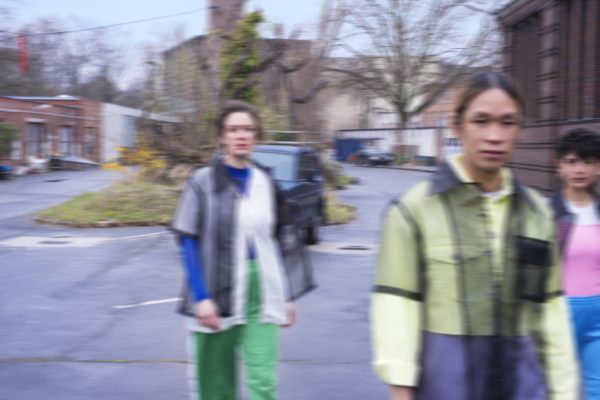This Space In Between

Photo: Kim Bode
Performance
Friday, 30 June 2023, 8.30 pm
Saturday, 1 July 2023, 8.30 pm
Uferstudios, yard
Uferstraße 23, 13357 Berlin
Free entry
Μην μ’ αρνηθείς, να ξαναρθείς
Ζήσαμε μαζί πόνους, πίκρες, χαρές
Αν με αρνηθείς, θα μας βρουν συμφορέςDon’t deny me, come again
We’ve lived together through pains, sorrows, joys
If you deny me, we’ll be in troubleVerleugne mich nicht, komm wieder
Wir haben zusammen Schmerzen, Sorgen und Freuden durchgestanden
Wenn du mich verleugnest, sind wir in Schwierigkeiten– Mimika Kazantzi: Μη μ’ αρνηθεις [Mi M’Arnitheis], 1963
https://www.youtube.com/watch?v=_x9cLtrK8CA
Singer Mimika Kazantzi’s voice appears between stories and greetings on the grandparents’ tape recordings. She conjures spaces between pain and empowerment, between Germany, Greece, Bollywood, between Laika and Schlager, between work on the assembly line and agricultural ecologies, between pasts and futures. Until the 1990s, mixtapes were an important migrant culture technique connecting people and their loved ones across different places around the world. They contained messages, music, spoken letters, warnings and dreams, longings, griefs and utopias. As transterritorial archives of self-made radio landscapes and disco polyphonies, migrant mixtapes form a starting point for the performance This Space In Between.
Inspired by the connections between migrant experiences and pop music, This Space In Between explores embodiments of in-between states. Through songs, sounds, remixes and calculated choreographies, three performers examine states of being in motion, arriving, not/working and celebrating for their inherent in-between places, in-between times, and in-between languages. Influenced by transgenerational migration experiences in Germany, by queer music cultures as well as by the losses and delights of the working class, the performers improvise post-migrant pop utopias. They employ polyphonies, hybridity and in-between cultures as choreographic strategies to claim space and as transformative paradigms for social and artistic formations.
Car parts on the assembly line become cows, memories intermingle. As a result of the recruitment agreements between the FRG and countries of the European and global South in the late 1950s, millions of people made their way to West Germany in search of work. Between 1963 and 1986, the GDR also concluded agreements with various so-called “brother states” (i.a. Vietnam) to train and employ workers in East Germany. Hands, backs, eyes, legs, inner organs – people were reduced to their labor power and their bodies were subjected to medical checks and racist interventions time and again. But these hands did not just work, they were also tender, creative, they loved, they played and fought. What has often been and continues to be rendered invisible is how generations of immigrants have created postmigrant cultures, politics, and forms of coexistence that are shaping the German society:ies.
In the yard of the Uferstudios, an architecture charged with traces of heavy physical and mechanized labor, This Space In Between generates a space at the intersection of performance and music, documentation and speculation. The industrial courtyard is turned into a place in constant formation, where worlds come together. In a continuous process of negotiating proximity and distance, performers and audience move on the same (dance)floor. The stage disintegrates and with it perhaps the habits of observing, hierarchical and racialising gazes.
In the Balkan and Mediterranean regions, polyphonic singing is a practice of communal living, celebrating, yearning and mourning. The sounds of different voices resonate equal to each other and to the melodies of birds, plants, water or wind. Together they compose an ecosystem, a landscape. Polyphony also describes a singer who sings different notes at the same time, a way of carrying contradictions and multiple affiliations on the tongue. This Space In Between explores polyphony in its political meaning as an idea of living together and as a performative practice that connects bodies.
What does the post-migrant pop utopia sound like? Can we dance to it?
Có bao nhiêu nắng ô kìa
Đà Lạt mơ mơ một sớm anh về
Có bao nhiêu gió ô kìa
Đà Lạt mơ mơ đâu dốc nhà anhVà nắng ô kìa nắng rất nhẹ
Dường như nụ cười của anh
Và gió ô kìa gió rất nhẹ
Dường như tiếng nói tiếng nói của anhHow much sunshine is there?
Đà Lạt dreams that one day you will come back
How much wind is there?
Đà Lạt dreams of where your house slopesAnd oh my god the sun is very light
Looks like your smile
And oh, the wind is so light
It seems that the voice of your voiceWieviel Sonne gibt es da?
Đà Lạt träumt von deiner Rückkehr eines Tages
Wieviel Wind gibt es da?
Đà Lạt träumt von dem Hang, wo dein Haus stehtUnd oh Gott die Sonne ist so zart
Sieht aus wie dein Lächeln
Und oh, der Wind ist so leicht
Es scheint die Stimme deiner Stimme
Team
Concept, Direction, Performance: Kallia Kefala | Performance: Minh Duc Pham, Katerina Papachristou | Composition, Live Music: Katerina Papachristou | Artistic Collaboration, Outside Eye: Sylvester Röpcke | Curatorial and research collaboration: District*School without Center (Suza Husse, Joe Ekenhorst, Promona Sengupta) | Communication: District*School without Center | Soundscapes: Kim Bode | Creative Producer: Martina Neu | Technical Direction: Cécile Perrot | Costume Collaboration: Aleix Llussa Lopez
Supported by Fonds Darstellende Künste with funds from the Federal Government Commissioner for Culture and Media within the program NEUSTART KULTUR.
